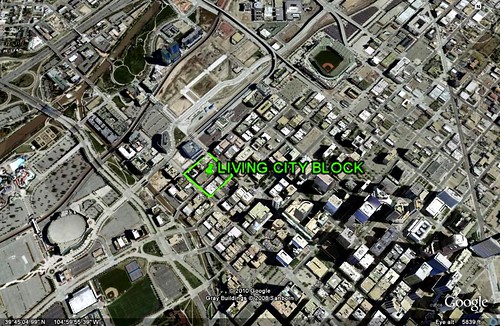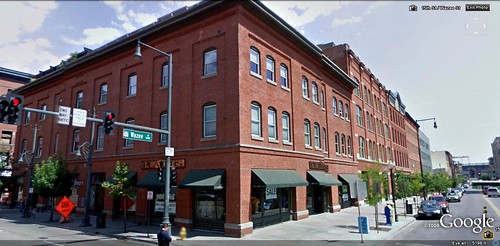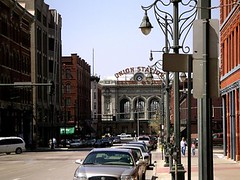Taking revitalization to the next level: Denver’s Living City Block

Posted March 11, 2010 at 3:14PM
The Living City Block is an ambitious project in Denver’s LoDo (Lower Downtown) to demonstrate the potential of combining environmentally conscious business and economic development with revitalization and livability. In this writer’s humble opinion, it is a fantastic concept that points to one of the ways in which we might shape a more sustainable future.
The project’s ambition is important. While smart growth and particularly revitalization are absolutely necessary to achieving more environmentally responsible communities, increasingly I am drawn to the conclusion that they are not enough. First, a paradox of smart growth is that, to reduce environmental impacts, we must concentrate them in certain places: this creates an obligation to do much more to mitigate them in those places than our current mainstream advocacy suggests. (More on that in a future post.) Second, the environmental challenges of future growth are so daunting that we must use all the knowledge and ability we have to address them. Our solutions must begin with smart growth, revitalization, and urbanism but cannot not end there.
This is why, though I wish it were more ambitious and demanding, LEED for Neighborhood Development is so important: it attempts to encourage a combination of smart growth (where we build), urbanism (what we build), and green technology (how development will function environmentally).
I am pleased to say that these issues are becoming more important to my organization. NRDC has just adopted a strategic plan that, for the first time in our history, elevates the issue of sustainable communities to the level of an institutional priority. About time. Partly as a result, I’ve been spending a lot of time examining these issues – have our thinking and advocacy evolved sufficiently to address 21st-century realities and possibilities? – and I am particularly encouraged to see some emerging models that take a holistic approach to the future of our built environment.
The Living City Block, being pursued by a partnership of the Rocky Mountain Institute and the city of Denver, looks terrific. On the project’s website, its sponsors describe its ambition:
“Living City Block will create a leading demonstration of a regenerative urban center.
“Two prominent city blocks in lower downtown Denver will significantly reduce their energy consumption and environmental impact, while showing a continual transformation towards a thriving, sustainable community.”
The project ultimately seeks to generate more energy than it will consume.
In the images accompanying this post, you can see the conceptual vision for the project, its location and, thanks to the wonders of Google Earth’s street view feature, what a portion of the site currently looks like. It is fitting that it is placed in LoDo, Denver’s showcase neighborhood of walkable revitalization. Note on the location image that Denver’s historic Union Station is just to the north and that the project site is in between Coors Field, the city’s major league baseball stadium, and the Pepsi Center (gotta love these corporate names), a major indoor arena. The heart of Denver’s downtown is within easy walking distance to the southeast.
I absolutely love that RMI and the city are doing this in a walkable urban environment anchored by historic preservation (see photos just above of LoDo). Bravo. Writing in Cool Town Studios, Neil Takemoto lists the ways in which the project seeks to realize its vision:
- Focusing on retrofitting and renovating existing buildings.
- Having buy-in from 80% of the building owners to uphold the mission.
- Benefitting from a diversity of active non-profit, educational, business and government partners.
- Providing an opportunity to pioneer features such as buildings producing more energy than they use, “last mile’ mobility solutions, energy capturing sidewalks, green leases, charging stations for plug-in vehicles, large-scale solar installation, urban agriculture/living roofs, vertical gardens, onsite renewables, co-generation, home metering, IT-driven consumer behavioral change… all in one place, all on one block.
- Attracting workers and entrepreneurs to such a progressive destination, spurring job creation.
- Linking it with the inauguration of the Biennial of the Americas, a month long “cultural celebration of innovation, imagination and the artistic achievement of the Western Hemisphere,” starting July 2010.
Great stuff. Go here for a four-page summary of the details.




